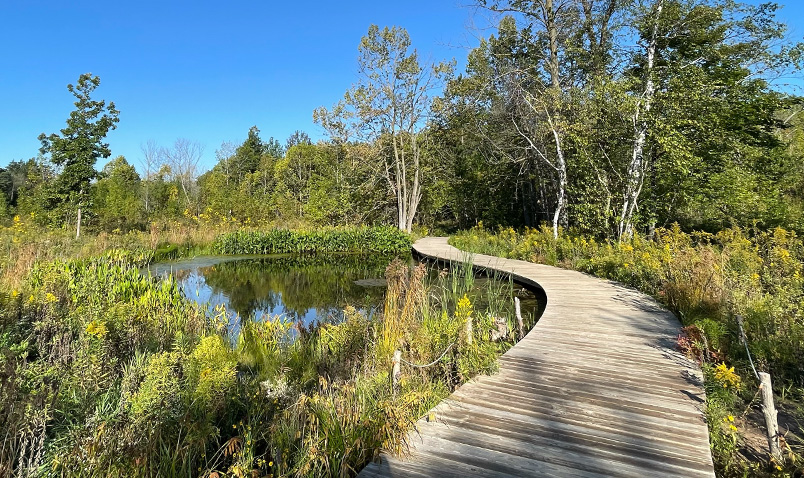
Central Wetlands Loop Accessible Trail Project
The Central Wetlands Loop is at the heart of the Schlitz Audubon trail experience. This large trail loop is easy to find and simple to navigate, facilitating awe-inspiring outdoor experiences and plentiful educational opportunities. This loop maintains the integrity of key wetlands while providing enhanced access to visitors.
In late 2023, we completed making the entire one-mile Central Wetlands Loop accessible to all, including people who use strollers, wheelchairs, or other mobility devices. All segments in this loop are now made of either crushed limestone or elevated boardwalk and take visitors through wildlife rich habitats.
Conservation Value of the Central Wetlands Loop
Overall, the Central Wetlands Loop takes visitors to both ephemeral and permanent ponds. As part of the Center’s Conservation Management Plan, our conservation team strives to conserve and restore wildlife populations of greatest conservation need. To that end, ephemeral ponds are left undisturbed to ensure that sensitive breeding amphibians and other aquatic organisms can thrive.
Care is being taken to ensure the conservation value of all ponds on this loop. The loop meanders over Teal Pond, Molly’s Pond, and Mystery Lake and includes a connecting trail to Dragonfly Pond. Each of these wetlands is unique: Mystery Lake is a haven for turtles, frogs, and waterfowl. Teal Pond is an insect sanctuary. Both Molly’s Pond and Dragonfly Pond, created only five years ago as a part of our Stormwater Wetland and Ravine Restoration Project, are flourishing with aquatic plants like pickerelweed, arrowhead, and marsh marigold.
Hikers will glimpse prairie and ravine habitats carefully restored with more than 25,000 trees, shrubs, and plants. Oak savanna invites visitors to become immersed in rippling waves of bluestem grasses, goldenrods, asters, and sunflowers during the growing season, or to appreciate beautiful wide expanses of fresh-fallen snow during winter months.
Forested habitats on the Central Wetlands Loop offer a peaceful retreat. Hikers experience southern mesic forest habitats in all their splendor with cathedral-like canopies, including new tree plantings of bur oak, hackberry, and sugar maple. Shrub plantings include pasture rose, elderberry, and meadowsweet. When in season, Pennsylvania sedge, marsh blazing star, and cardinal flower will provide beautiful blooms and nutrients essential to pollinator species.
In spring, native woodland ephemerals herald the return of new life. Walking along the rim of the North Ravine, visitors have a bird’s-eye view of some of the highest quality forested Lake Michigan ravine habitat remaining in Milwaukee County.
Educational Value of the Project
The increased access of the Central Wetland’s Loop trail system ensures that all visitors experience the plentiful educational opportunities offered by numerous habitats and wildlife areas. In addition to creating access for more visitors, this important trail conversion helps to protect adjacent habitats. By alleviating soil compaction and preventing run-off into the ravine, the enhanced trail better allows native plants, pollinators, and animals to thrive.
Giving all visitors access to these varied and important habitats, through educational programs or individual exploration, will provide enhanced experiences and inform them about the importance of our region’s vital habitats.